Mesoscopic Numerical Simulation of Freeze–Thaw Damage in Hydraulic Concrete
Abstract
1. Introduction
2. Generating a Mesoscopic Numerical Model for Concrete
2.1. Generation of a Random Aggregate Model
2.1.1. Generation of Individual Polygon Aggregates
2.1.2. Generating an Aggregate Library
2.1.3. Aggregate Placement
2.2. Generation of the ITZ
2.3. Generation of Two-Dimensional Mesoscopic Models
3. Establishment and Validation of the Concrete Freeze–Thaw Damage Model
3.1. Mechanical Performance Testing and Results
3.1.1. Specimen Fabrication
3.1.2. Test
3.2. Establishment of the Freeze–Thaw Damage Model
- (1)
- Parameters of the concrete compressive stress–strain curve
- (2)
- Parameters of tensile stress–strain curve of concrete
- (i)
- Relative tensile strength
- (ii)
- Relative peak tensile strain
- (iii)
- Decline segment parameter ratio
- (3)
- Relative Poisson’s ratios
3.3. Validation of Fine-Scale Numerical Simulation of the Freeze–Thaw Damage Model
4. Parametric Study of Fine-Scale Numerical Simulation of Concrete Freeze–Thaw Damage
4.1. Effect of Changes in the Ratio of Concrete Mechanical Properties at the ITZ
4.2. Effect of Changes in the Coarse Aggregate Content Variation on Concrete Mechanical Properties
5. Conclusions
- (1)
- Generating polygonal random aggregates based on circular aggregates is simple and can effectively reduce the complexity of edge-to-edge determination. By extending to a certain distance from the vertices of the polygonal aggregates, the ITZ can be generated. This method can not only meet the required aggregate packing density, but also facilitate grid division directly in the Abaqus software.
- (2)
- The numerical simulation results of the freeze–thaw damage model fit well with the experimental data for the stress–strain curves, with the relative errors of all mechanical performance parameters being below 7%. This indicates that the model can accurately simulate the mechanical properties of the mesoscopic concrete after freeze–thaw damage, further confirming the reliability and rationality of the freeze–thaw damage mesoscopic model.
- (3)
- Higher ITZ parameter ratios improve the mechanical properties of the ITZ in concrete, leading to increased compressive strength and peak compressive strain, but they have almost no impact on the elastic modulus. Compared to the ratios of 0.7 and 0.8, concrete with a ratio of 0.9 experiences slower reduction rates in compressive strength and elastic modulus and a slower increase rate in peak compressive strain after undergoing freeze–thaw cycles. Increasing the ITZ parameter ratio enhances the mechanical properties of the ITZ and strengthens the concrete’s resistance to freezing.
- (4)
- Concrete with a higher coarse aggregate content exhibits a higher compressive strength, peak compressive strain, and elastic modulus. Compared to that with contents of 40% and 50%, concrete with a content of 60% experiences slower reduction rates in compressive strength and elastic modulus and a slower increase rate in peak compressive strain after undergoing freeze–thaw cycles, indicating that increasing the coarse aggregate content enhances the concrete’s strength and frost resistance.
Author Contributions
Funding
Data Availability Statement
Conflicts of Interest
References
- Bahrami, N.; Zohrabi, M.; Mahmoudy, S.A.; Akbari, M. Optimum recycled concrete aggregate and micro-silica content in self-compacting concrete: Rheological, mechanical and microstructural properties. J. Build. Eng. 2020, 31, 101361. [Google Scholar] [CrossRef]
- Li, T.; Wang, S.L.; Xu, F. Study of the basic mechanical properties and degradation mechanism of recycled concrete with tailings before and after carbonation. J. Clean. Prod. 2020, 259, 120923. [Google Scholar] [CrossRef]
- Ren, R.; Qi, L.J.; Xue, J.Y.; Zhang, X. Cyclic bond property of steel reinforced recycled concrete (SRRC) composite structure. Constr. Build. Mater. 2020, 245, 118435. [Google Scholar] [CrossRef]
- Zhang, M.J.; Yu, H.F.; Zhang, J.H.; Chen, B.Y.; Ma, H.Y.; Gong, X.; Guo, J.B.; Yu, W.M.; Li, L.Y. Finite element analysis of stress–strain relationship and failure pattern of concrete under uniaxial compression considering freeze–thaw action. Eng. Fract. Mech. 2023, 290, 109520. [Google Scholar] [CrossRef]
- Liu, S.; Liu, H.D.; Liu, H.N.; Xia, Z.G.; Zhao, Y.W.; Zhai, J.Y. Numerical simulation of mesomechanical properties of limestone containing dissolved hole and persistent joint. Theor. Appl. Fract. Mech. 2022, 122, 103572. [Google Scholar] [CrossRef]
- Liu, M.M.; Wang, F.T. Numerical simulation of influence of coarse aggregate crushing on mechanical properties of concrete under uniaxial compression. Constr. Build. Mater. 2022, 342, 128081. [Google Scholar] [CrossRef]
- Chatterji, S. Aspects of freezing process in porous material-water system: Part 2. Freezing and properties of frozen porous materials. Cem. Concr. Res. 1999, 29, 781–784. [Google Scholar] [CrossRef]
- Deng, X.H.; Gao, X.Y.; Wang, R.; Gao, M.X.; Yan, X.X.; Cao, W.P.; Liu, J.T. Investigation of microstructural damage in air-entrained recycled concrete under a freeze–thaw environment. Constr. Build. Mater. 2021, 268, 121219. [Google Scholar] [CrossRef]
- Luo, Q.; Liu, D.; Qiao, P.; Feng, Q.; Sun, L. Microstructural damage characterization of concrete under freeze-thaw action. Int. J. Damage Mech. 2018, 27, 1551–1568. [Google Scholar]
- He, R.; Zheng, S.N.; Vincent, J.L.G.; Wang, Z.D.; Fang, J.H.; Shao, Y. Damage mechanism and interfacial transition zone characteristics of concrete under sulfate erosion and Dry-Wet cycles. Constr. Build. Mater. 2020, 255, 119340. [Google Scholar] [CrossRef]
- Golewski, G.L. Physical characteristics of concrete, essential in design of fracture-resistant, dynamically loaded reinforced concrete structures. Mater. Des. Process. Commun. 2019, 1, e82. [Google Scholar] [CrossRef]
- Ippei, M.; Hiroshi, S.; Mao, L. Impact of aggregate properties on the development of shrinkage-induced cracking in concrete under restraint conditions. Cem. Concr. Res. 2016, 85, 82–101. [Google Scholar]
- Jiang, S.Q.; He, Z.H.; Zhou, Y.P.; Xiao, X.W.; Cao, G.D.; Tong, Z.G. Numerical simulation research on suction process of concrete pumping system based on CFD method. Powder Technol. 2022, 409, 117787. [Google Scholar] [CrossRef]
- Jin, L.B.; Wang, Z.H.; Yang, B.; Wu, T.; Wu, Q.; Zhou, P. Mesoscopic numerical simulation of sulfate ion transport behavior in concrete based on a new damage model. Structures 2024, 61, 106066. [Google Scholar] [CrossRef]
- Wu, T.; Jin, L.B.; Fan, T.; Qiao, L.R.; Liu, P.; Zhou, P.; Zhang, Y.S. A multi-phase numerical simulation method for the changing process of expansion products on concrete under sulfate attack. Case Stud. Constr. Mat. 2023, 19, e02458. [Google Scholar] [CrossRef]
- Dong, Q.; Zheng, H.R.; Zhang, L.J.; Sun, G.W.; Yang, H.T.; Li, Y.F. Numerical simulation on diffusion–reaction behavior of concrete under sulfate–chloride coupled attack. Constr. Build. Mater. 2023, 405, 133237. [Google Scholar]
- Gan, L.; Feng, X.W.; Zhang, H.W.; Shen, Z.Z.; Xu, L.Q.; Zhang, W.B.; Sun, Y.Q. Three-dimensional mesonumerical model of freeze-thaw concrete based on the porosity swelling theory. J. Mater. Civil. Eng. 2023, 35, 05023005. [Google Scholar] [CrossRef]
- Miao, H.B.; Guo, C.; Lu, Z.R.; Chen, Z.H. 3D mesoscale analysis of concrete containing defect damages during different freeze-thaw cycles. Constr. Build. Mater. 2022, 358, 129449. [Google Scholar] [CrossRef]
- Shi, X.Y.; Zhang, C.; Liu, Z.Y.; Van den Heede, P.; Wang, L.; De Belie, N.; Yao, Y. Numerical modeling of the carbonation depth of meso-scale concrete under sustained loads considering stress state and damage. Constr. Build. Mater. 2022, 340, 127798. [Google Scholar] [CrossRef]
- Liu, B.; Zhang, B.; Wang, Z.Z.; Bai, G.L. Study on the stress–strain full curve of recycled coarse aggregate concrete under uniaxial compression. Constr. Build. Mater. 2023, 363, 129884. [Google Scholar] [CrossRef]
- Wang, H.T.; Zhou, Y.; Shen, J.Y. Experimental study of dynamic biaxial compressive properties of full grade aggregate concrete after freeze thaw cycles. Cold Reg. Sci. Technol. 2023, 205, 103710. [Google Scholar] [CrossRef]
- Zhang, H.B.; Wang, J.; Liu, Z.K.; Ma, C.Y.; Song, Z.S.; Cui, F.; Wu, J.Q.; Song, X.G. Strength characteristics of foamed concrete under coupling effect of constant compressive loading and freeze-thaw cycles. Constr. Build. Mater. 2024, 411, 134565. [Google Scholar] [CrossRef]
- Xie, F.X.; Jin, Z.H.; Yang, T.F.; Han, X.; Chen, X.D.; Zhang, Y. Experimental study of dynamic splitting-tensile properties of precast concrete samples under different strain rates. Constr. Build. Mater. 2023, 372, 130748. [Google Scholar] [CrossRef]
- Zhu, X.Y.; Chen, X.D.; Zhang, N.; Wang, X.Q.; Diao, H.G. Experimental and numerical research on triaxial mechanical behavior of self-compacting concrete subjected to freeze–thaw damage. Constr. Build. Mater. 2021, 288, 123110. [Google Scholar] [CrossRef]
- Zhou, L.; Deng, Z.P.; Li, W.L.; Ren, J.R.; Zhu, Y.H.; Mao, L. Mechanical behavior of the cellular concrete and numerical simulation based on meso-element equivalent method. Constr. Build. Mater. 2023, 394, 132118. [Google Scholar] [CrossRef]
- Gan, L.; Liu, G.H.; Liu, J.; Zhang, H.W.; Feng, X.W.; Li, L.C. Three-dimensional microscale numerical simulation of fiber-reinforced concrete under sulfate freeze-thaw action. Case Stud. Constr. Mat. 2024, 20, e03308. [Google Scholar] [CrossRef]
- Duan, A.; Jin, W.; Qian, J. Effect of freeze–thaw cycles on the stress–strain curves of unconfined and confined concrete. Mater. Struct. 2011, 44, 1309–1324. [Google Scholar] [CrossRef]
- Dong, Q.; Zhao, X.K.; Chen, X.Q.; Yuan, J.W.; Hu, W.; Jahanzaib, A. Numerical simulation of mesoscopic cracking of cement-treated base material based on random polygon aggregate model. J. Traffic Transp. Eng. 2023, 10, 454–468. [Google Scholar] [CrossRef]
- Wang, H.L.; Zhu, W.H.; Qin, S.F.; Tan, Y.G. Numerical simulation of steel corrosion in chloride environment based on random aggregate concrete microstructure model. Constr. Build. Mater. 2022, 331, 127323. [Google Scholar] [CrossRef]
- Ma, H.F.; Xu, W.X.; Li, Y.C. Random aggregate model for mesoscopic structures and mechanical analysis of fully-graded concrete. Comput. Struct. 2016, 177, 103–113. [Google Scholar]
- Zhou, G.T.; Xu, Z.H. 3D mesoscale investigation on the compressive fracture of concrete with different aggregate shapes and interface transition zones. Constr. Build. Mater. 2023, 393, 132111. [Google Scholar] [CrossRef]
- Šavija, B.; Luković, M.; Pacheco, J.; Schlangen, E. Cracking of the concrete cover due to reinforcement corrosion: A two-dimensional lattice model study. Constr. Build. Mater. 2013, 44, 626–638. [Google Scholar] [CrossRef]
- Wang, B.; Wang, H.; Zhang, Z.Q.; Zhou, M.J. A Mesoscopic Modeling Method for Random Concave Convex Concrete Aggregates Based on Grid Generation. J. Comput. Mech. 2017, 34, 591–596. (In Chinese) [Google Scholar]
- Du, M.; Jin, L.; Li, D.; Du, X.L. Microscopic numerical study on the influence of aggregate particle size on the splitting tensile performance and size effect of concrete. Eng. Mech. 2017, 34, 54–63. (In Chinese) [Google Scholar]
- Akcay, B.; Agar-Ozbek, A.S.; Bayramov, F. Interpretation of aggregate volume fraction effects on fracture behavior of concrete. Constr. Build. Mater. 2012, 28, 437–443. [Google Scholar] [CrossRef]
- Chen, B.; Liu, J. Effect of aggregate on the fracture behavior of high strength concrete. Constr. Build. Mater. 2004, 18, 585–590. [Google Scholar] [CrossRef]
- GB/T 14684-2022; Sand for Construction. Ministry of Housing and Urban Rural Development of the People’s Republic of China, GB/T: Beijing, China, 2022. (In Chinese)
- GB/T 50081-2019; Standard for Test Methods of Concrete and Mechanical Properties. State Administration for Market Regulation, GB/T: Beijing, China, 2019. (In Chinese)
- GB/T 50082-2009; Standard Test Methods for Long-Term Performance and Durability of Ordinary Concrete. Ministry of Housing and Urban Rural Development of the People’s Republic of China, GB/T: Beijing, China, 2009. (In Chinese)
- Sun, M.; Xin, D.B.; Zou, C.Y. Damage evolution and plasticity development of concrete materials subjected to freeze-thaw during the load process. Mech. Mater. 2019, 139, 103192. [Google Scholar] [CrossRef]
- Cao, D.F.; Fu, L.Z.; Yang, Z.W. Research on tensile properties of concrete under freeze-thaw cycles. J. Build. Mater. 2012, 15, 48–52. (In Chinese) [Google Scholar]
- Shang, H.S.; Song, Y.P.; Qin, L.K. Experimental study on properties of ordinary concrete after freeze-thaw cycles. Concr. Cem. Prod. 2005, 2, 9–11. (In Chinese) [Google Scholar]
- Li, C.; Chen, H.Z.; He, Z.; Gu, X.P. Analysis of concrete structure life under freezing thawing cycle conditions. Eng. J. Wuhan. Univ. 2010, 2, 54–57. (In Chinese) [Google Scholar]
- Huang, Y.; Yang, Z.; Ren, W. 3D meso-scale fracture modelling and validation of concrete based on in-situ X-ray Computed Tomography images using damage plasticity model. Int. J. Solids Struct. 2015, 67, 340–352. [Google Scholar] [CrossRef]
- Jin, L.; Zhang, R.; Du, X. Computational homogenization for thermal conduction in heterogeneous concrete after mechanical stress. Constr. Build. Mater. 2017, 141, 222–234. [Google Scholar] [CrossRef]
- Kim, S.M.; Al-Rub, R.K.A. Meso-scale computational modeling of the plastic-damage response of cementitious composites. Cem. Concr. Res. 2011, 41, 339–358. [Google Scholar] [CrossRef]
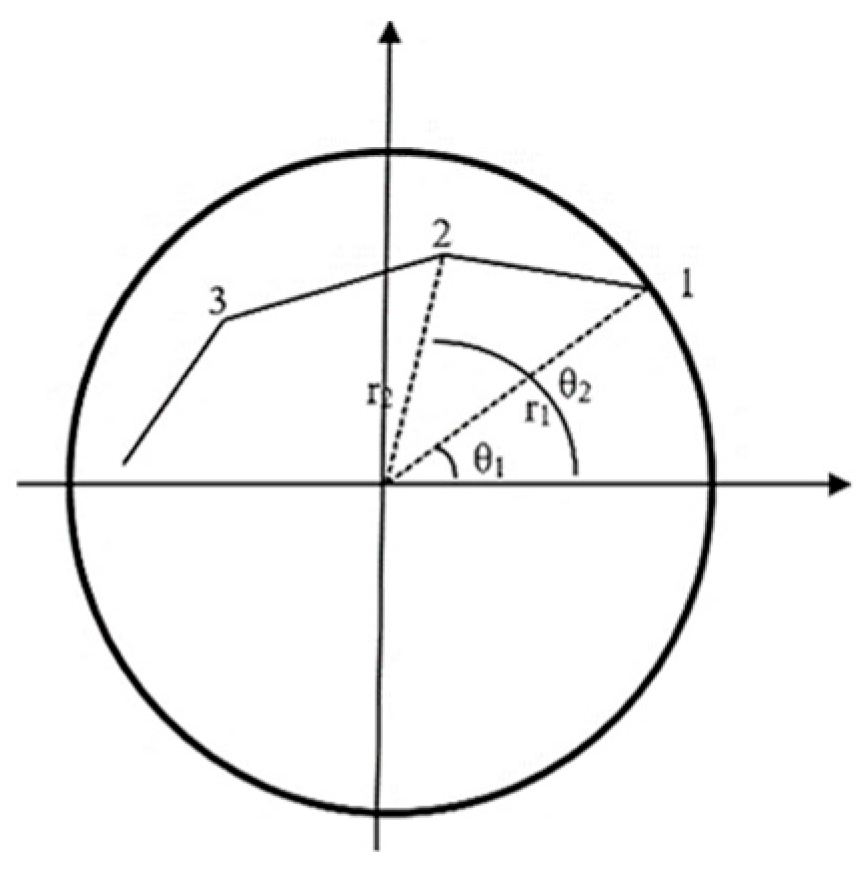

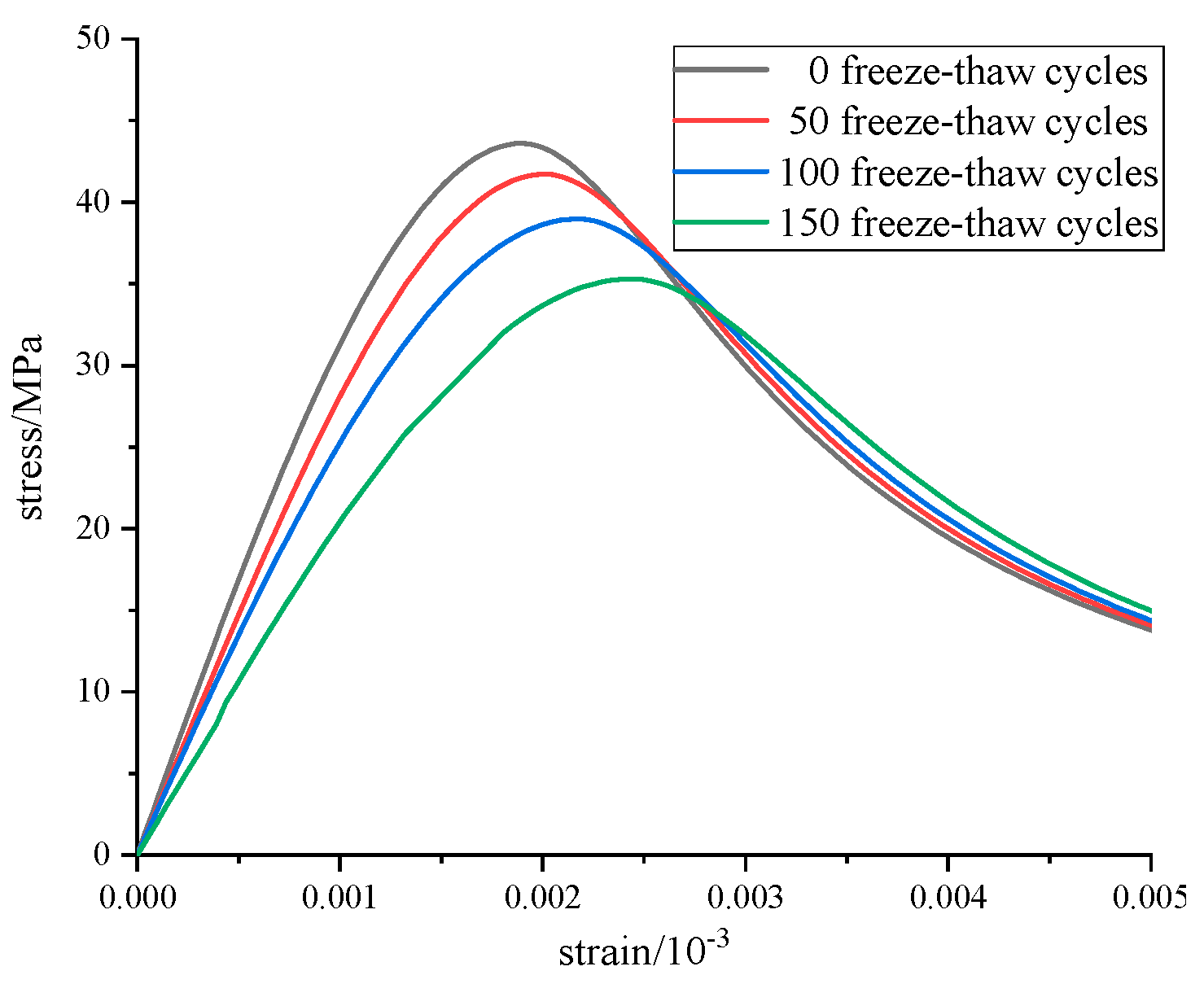
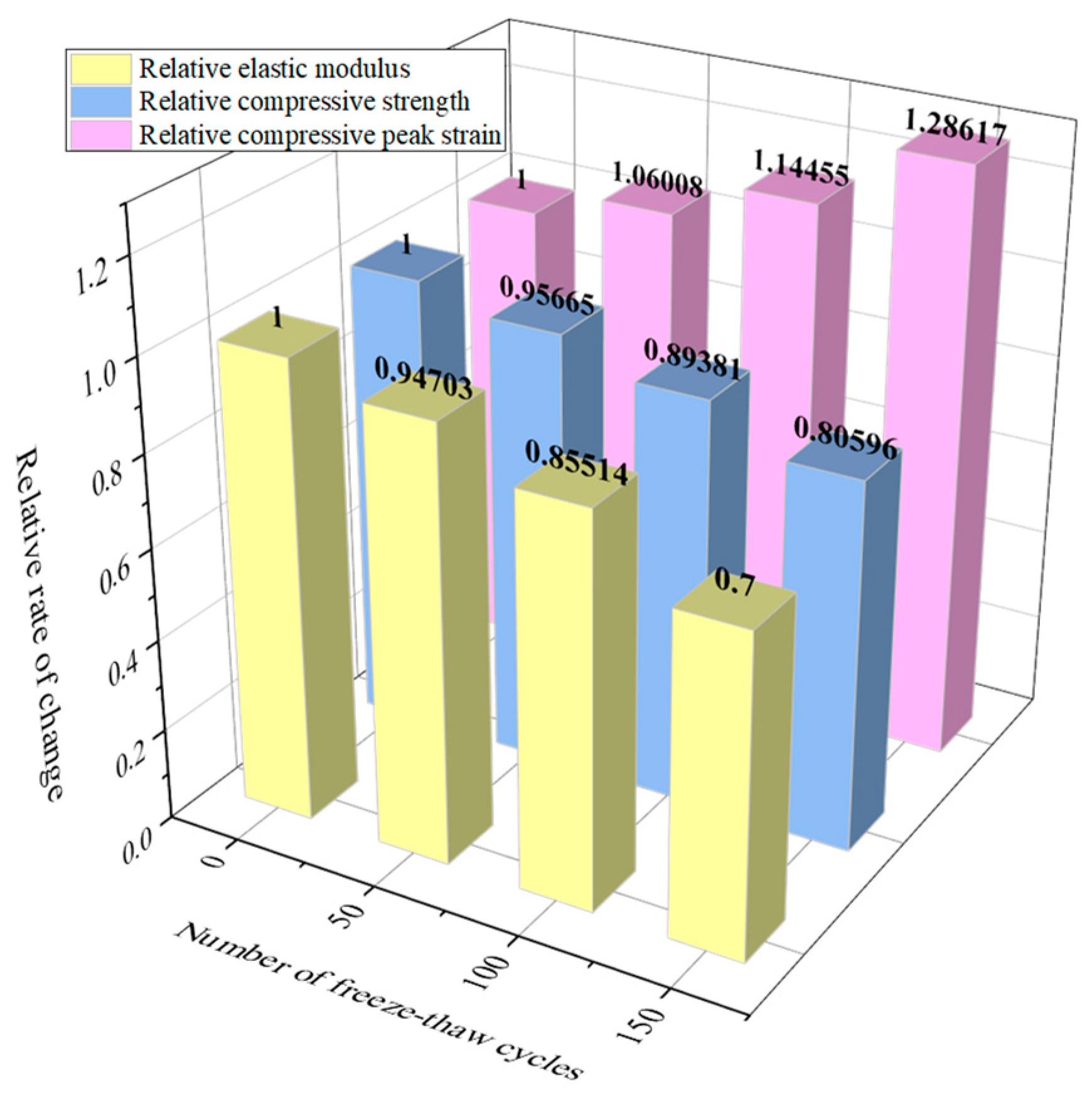
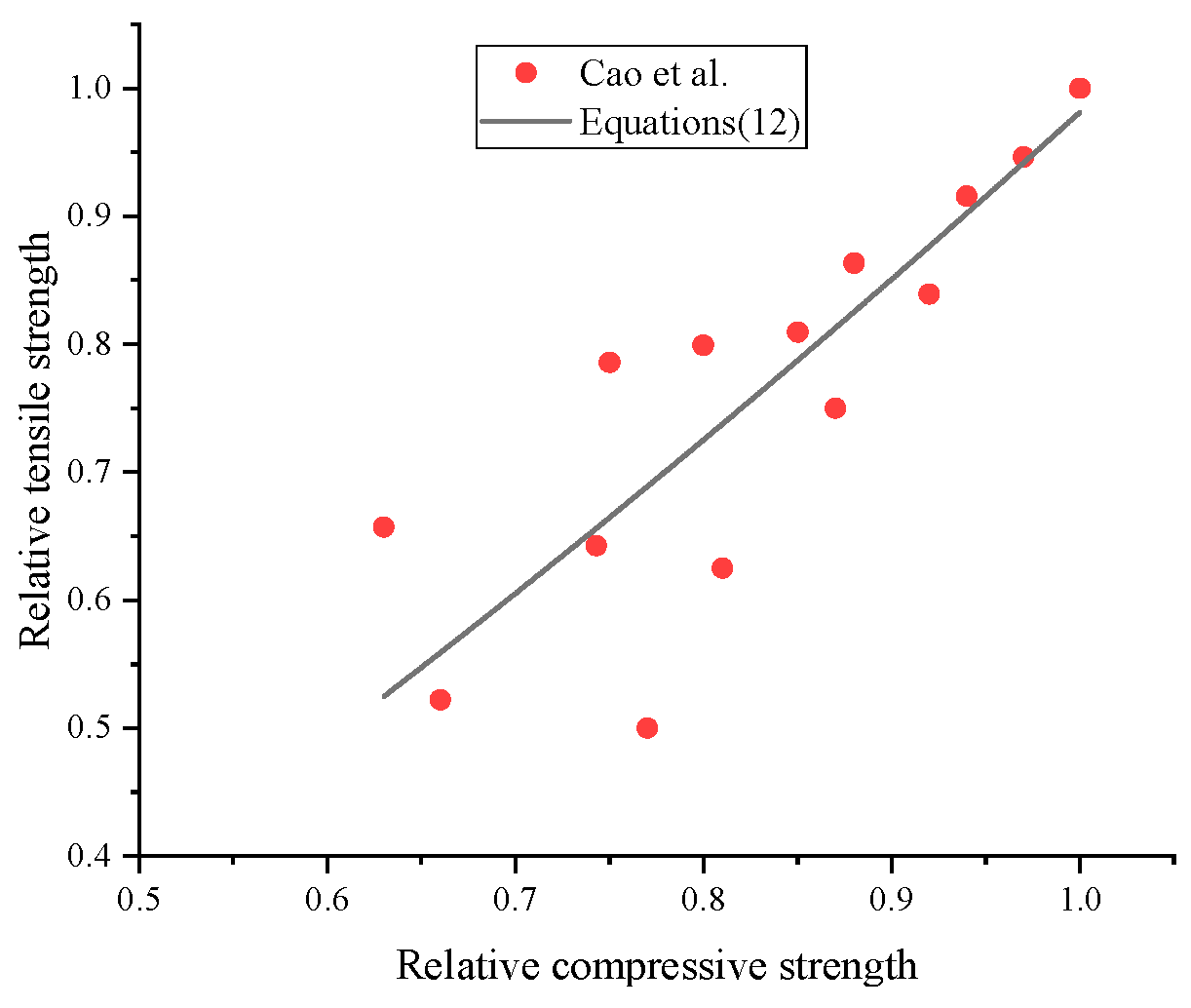

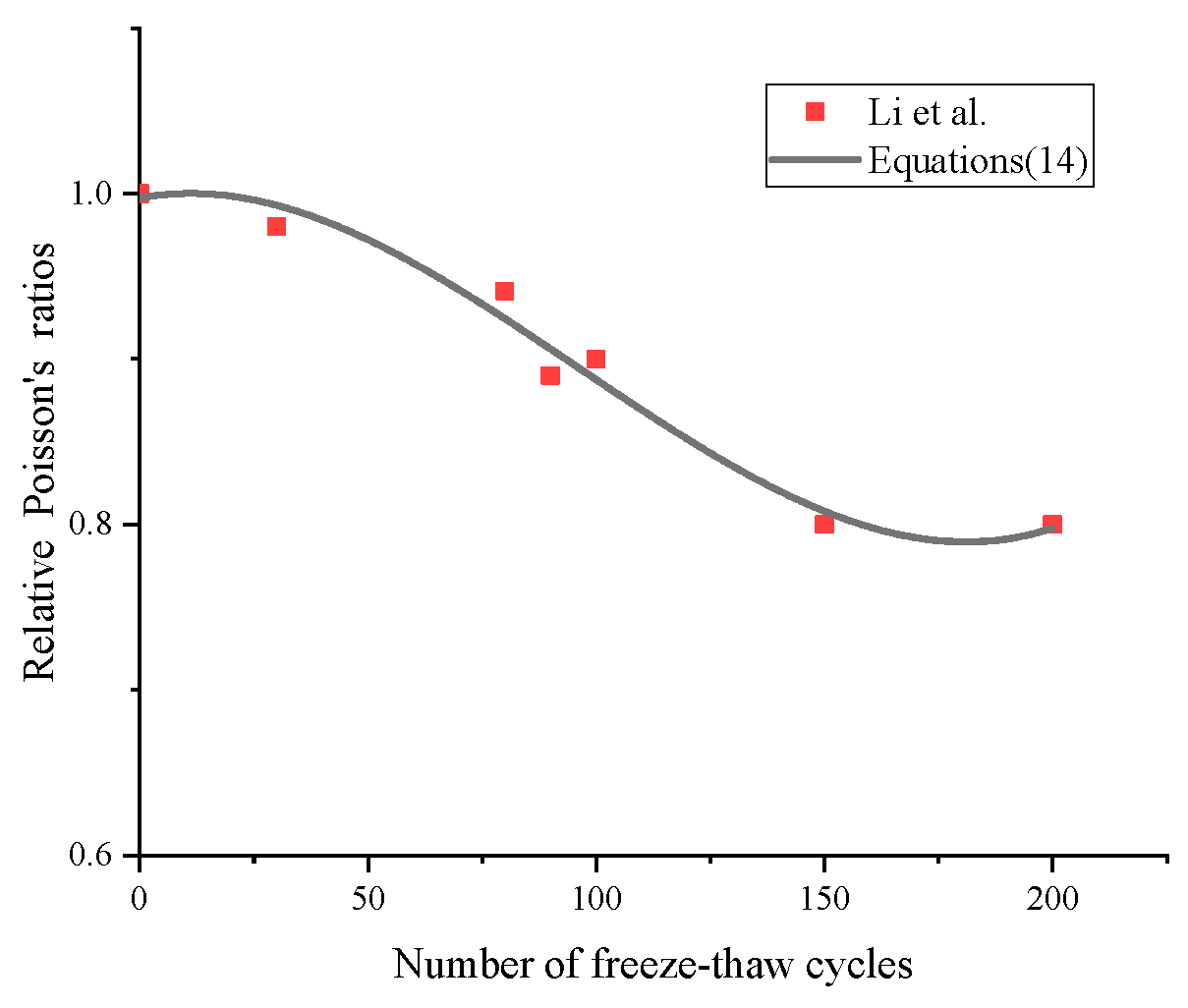
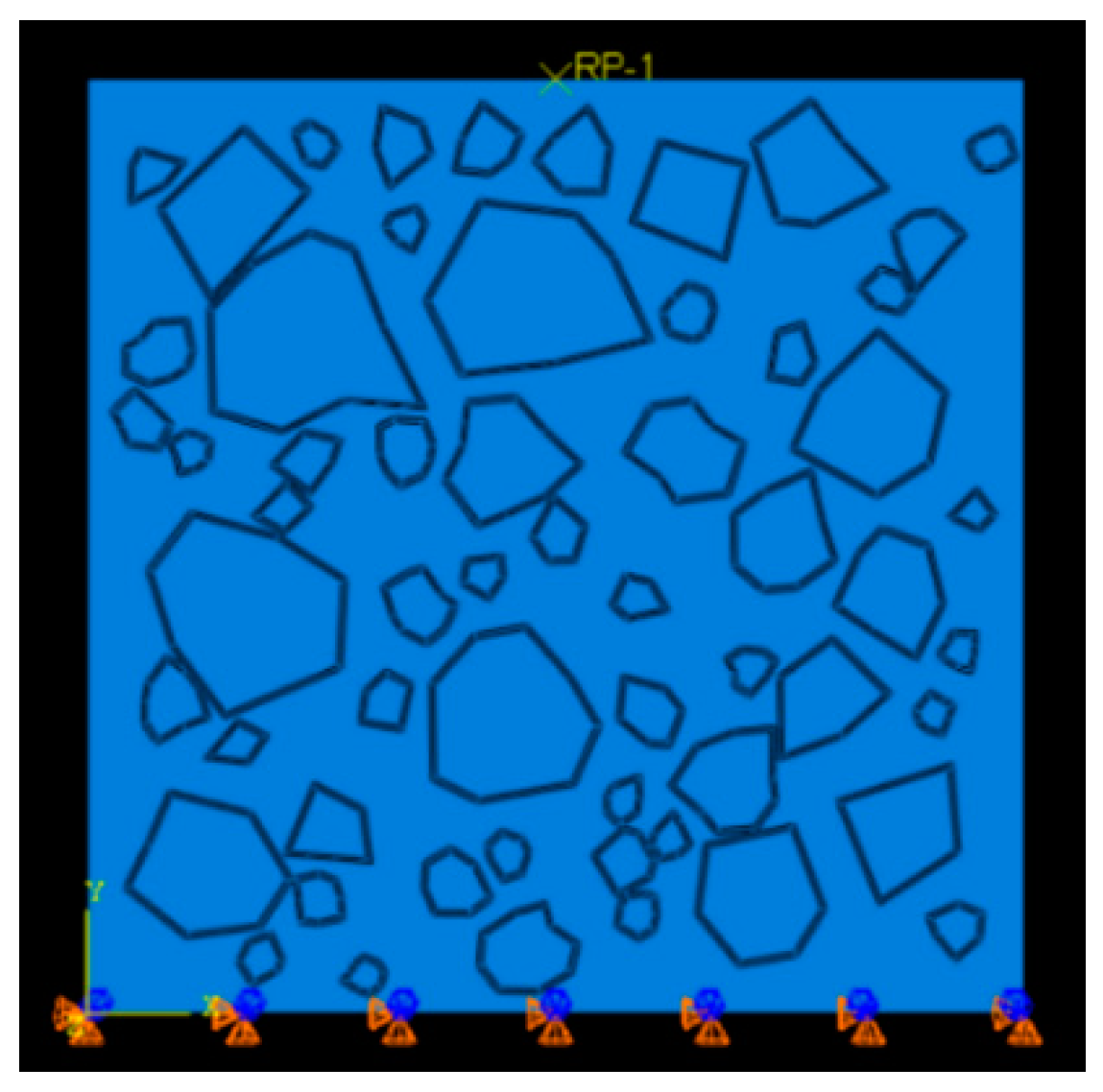
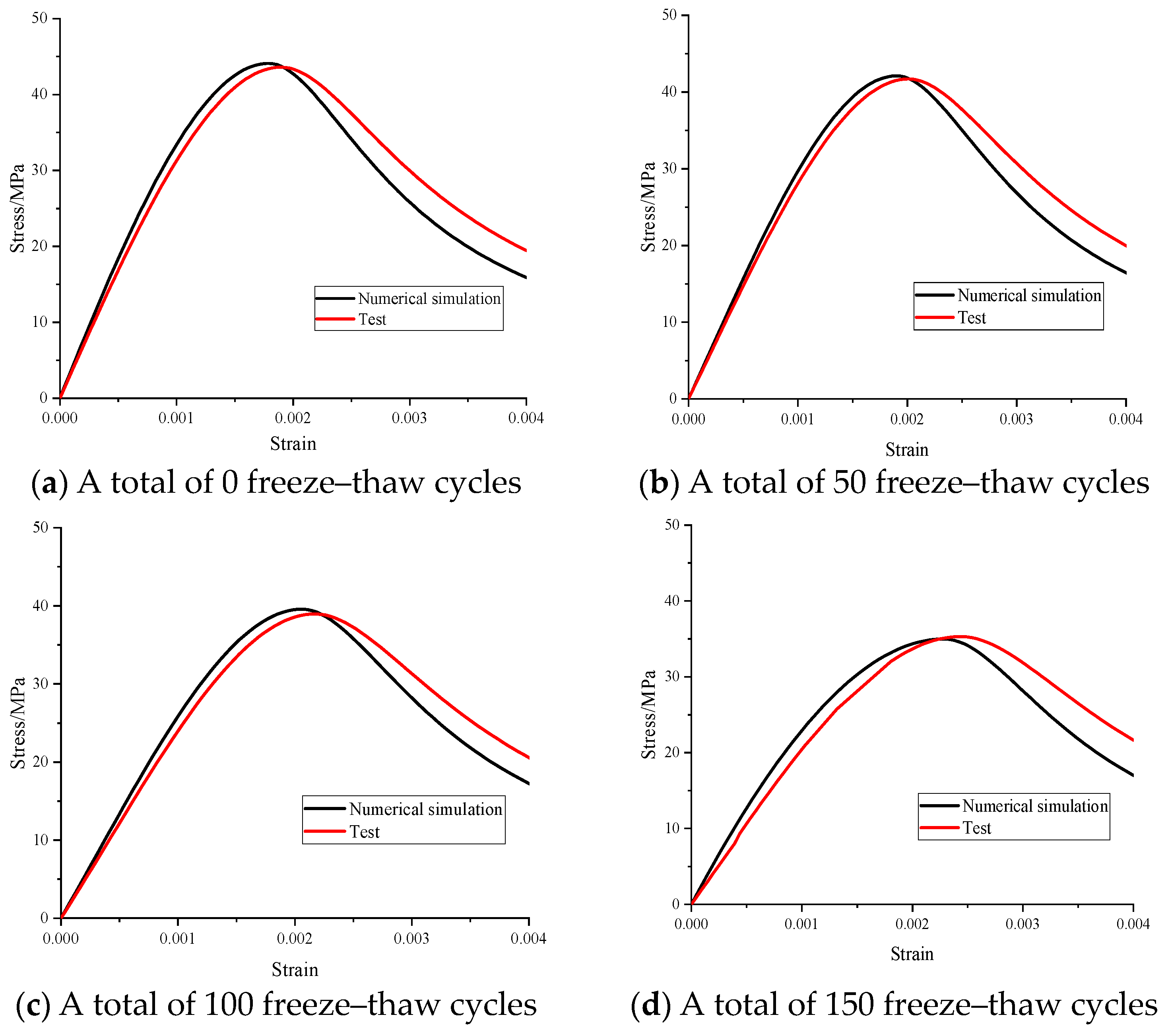
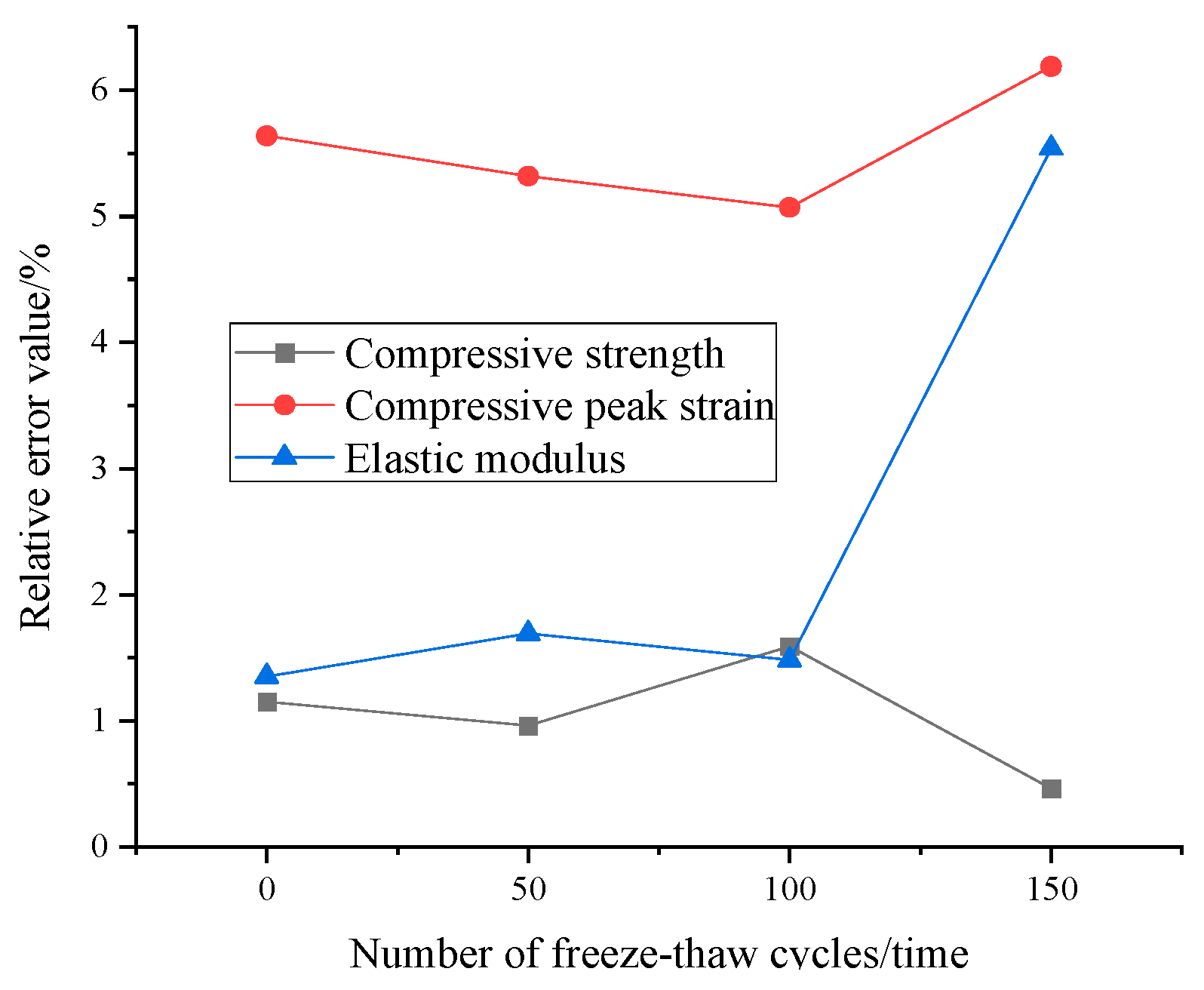



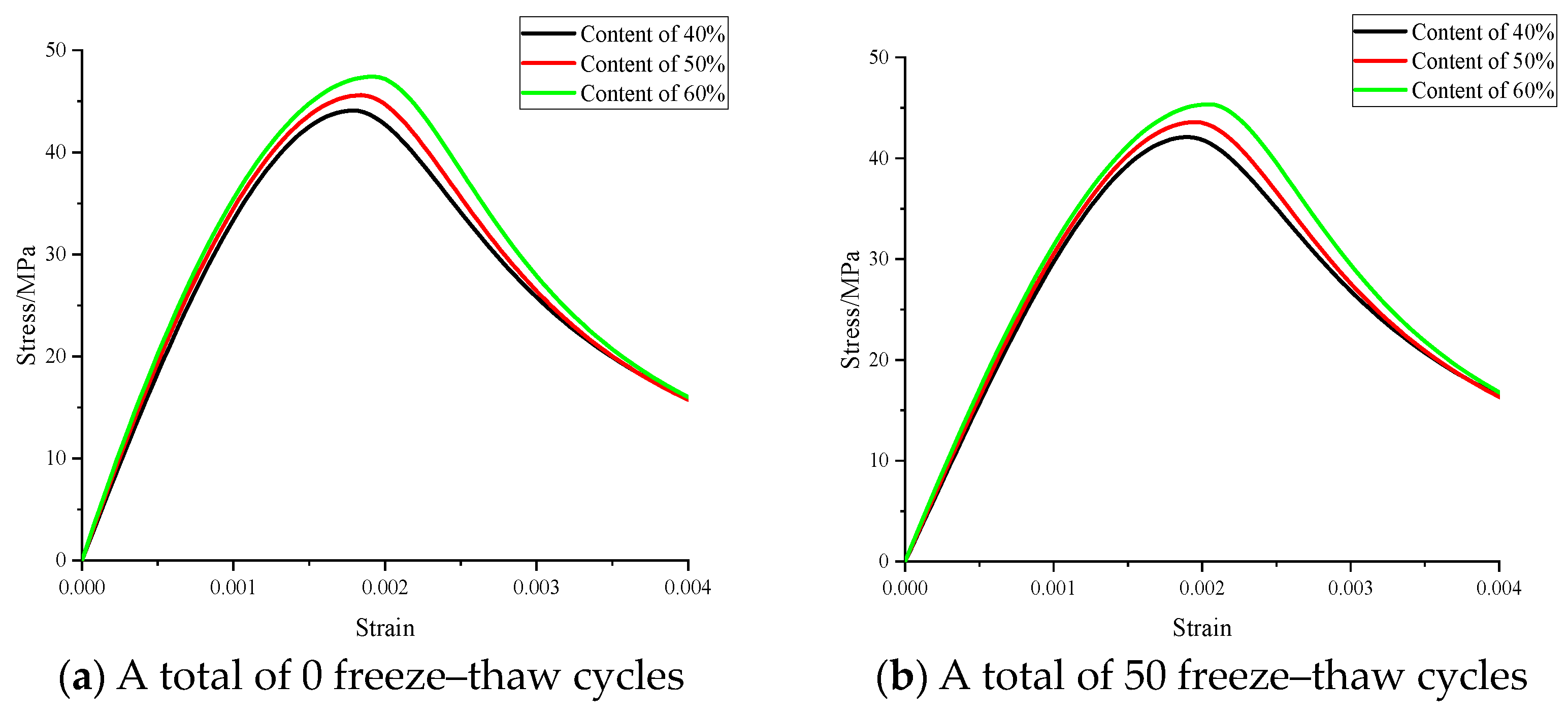


| Water–Cement Ratio | Water (kg/m3) | Cement (kg/m3) | Fly Ash (kg/m3) | Fine Aggregates (kg/m3) | Coarse Aggregates (kg/m3) | Water Reducer (%) | Air-Entraining Agent (%) |
|---|---|---|---|---|---|---|---|
| 0.35 | 141 | 352 | 53 | 688 | 1221 | 0.96 | 0.027 |
| Number of freeze–thaw cycles (n). | 0 | 50 | 100 | 150 |
| Upstage parameter | 1.57 | 1.46 | 1.35 | 1.21 |
| Descending stage parameter | 2.13 | 2.21 | 2.32 | 2.53 |
| Freeze–Thaw Cycle Number | Compressive Strength (MPa) | Compression Strength Variation Rate (%) | Variation Rate of Compressive Peak Strain (%) | Variation Rate of Elastic Modulus (%) | ||||||||
|---|---|---|---|---|---|---|---|---|---|---|---|---|
| 0.7 | 0.8 | 0.9 | 0.7 | 0.8 | 0.9 | 0.7 | 0.8 | 0.9 | 0.7 | 0.8 | 0.9 | |
| 0 | 42.88 | 44.10 | 45.20 | 0 | 0 | 0 | 0 | 0 | 0 | 0 | 0 | 0 |
| 50 | 40.56 | 42.11 | 43.45 | 5.41 | 4.51 | 3.87 | 6.95 | 6.37 | 5.88 | 5.60 | 5.23 | 4.94 |
| 100 | 37.81 | 39.59 | 41.21 | 11.82 | 10.23 | 8.83 | 15.56 | 15.14 | 13.89 | 15.23 | 14.63 | 13.87 |
| 150 | 33.01 | 34.98 | 36.94 | 23.02 | 20.68 | 18.27 | 30.40 | 27.88 | 24.73 | 28.72 | 27.77 | 27.05 |
| Freeze–Thaw Cycle Number | Compressive Strength (MPa) | Compression Strength Variation Rate (%) | Variation Rate of Compressive Peak Strain (%) | Variation Rate of Elastic Modulus (%) | ||||||||
|---|---|---|---|---|---|---|---|---|---|---|---|---|
| 40% | 50% | 60% | 40% | 50% | 60% | 40% | 50% | 60% | 40% | 50% | 60% | |
| 0 | 44.10 | 45.60 | 47.42 | 0 | 0 | 0 | 0 | 0 | 0 | 0 | 0 | 0 |
| 50 | 42.11 | 43.59 | 45.36 | 4.51 | 4.41 | 4.34 | 6.37 | 6.13 | 6.11 | 5.23 | 5.07 | 4.88 |
| 100 | 39.59 | 41.36 | 43.58 | 10.23 | 9.30 | 8.10 | 15.14 | 14.70 | 14.34 | 14.63 | 14.17 | 14.34 |
| 150 | 34.98 | 36.99 | 39.79 | 20.68 | 18.89 | 16.09 | 27.88 | 27.24 | 25.51 | 27.77 | 25.58 | 25.51 |
Disclaimer/Publisher’s Note: The statements, opinions and data contained in all publications are solely those of the individual author(s) and contributor(s) and not of MDPI and/or the editor(s). MDPI and/or the editor(s) disclaim responsibility for any injury to people or property resulting from any ideas, methods, instructions or products referred to in the content. |
© 2024 by the authors. Licensee MDPI, Basel, Switzerland. This article is an open access article distributed under the terms and conditions of the Creative Commons Attribution (CC BY) license (https://creativecommons.org/licenses/by/4.0/).
Share and Cite
Wang, R.; Liu, Y.; Liu, J.; Li, Y.; Jin, R.; Liang, G.; Yu, N.; Hu, J.; Zhou, H.; Jia, Y.; et al. Mesoscopic Numerical Simulation of Freeze–Thaw Damage in Hydraulic Concrete. Buildings 2024, 14, 2694. https://doi.org/10.3390/buildings14092694
Wang R, Liu Y, Liu J, Li Y, Jin R, Liang G, Yu N, Hu J, Zhou H, Jia Y, et al. Mesoscopic Numerical Simulation of Freeze–Thaw Damage in Hydraulic Concrete. Buildings. 2024; 14(9):2694. https://doi.org/10.3390/buildings14092694
Chicago/Turabian StyleWang, Ruijun, Yunhui Liu, Jun Liu, Yang Li, Ruibao Jin, Gang Liang, Ningning Yu, Jing Hu, Hekuan Zhou, Yaofei Jia, and et al. 2024. "Mesoscopic Numerical Simulation of Freeze–Thaw Damage in Hydraulic Concrete" Buildings 14, no. 9: 2694. https://doi.org/10.3390/buildings14092694
APA StyleWang, R., Liu, Y., Liu, J., Li, Y., Jin, R., Liang, G., Yu, N., Hu, J., Zhou, H., Jia, Y., & Liu, Y. (2024). Mesoscopic Numerical Simulation of Freeze–Thaw Damage in Hydraulic Concrete. Buildings, 14(9), 2694. https://doi.org/10.3390/buildings14092694







